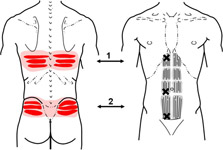Not too surprising about the lower abdominal cause of low back pain, but who would suspect the calf? This is a series on low back pain. If you missed the summary of causes, go back to Part 1.
 Here’s the rectus abdominus Trigger Point. So that’s obvious. Let’s look further. The lower abdominal muscles have a direct effect on the position of the low back. If they are weak, the low back muscles will be tight and the pelvis will tip forward. This is the physiological principle of reciprocal inhibition that contraction of one muscle inhibits the contraction of the muscle that works opposite to it for as long as the muscle is contracting. So chronic contraction in one set produces chronic weakness in the opposing set. The imbalance results in compensation by other helper muscles and eventually some imbalance and then dysfunction in the bony joints held by them.
Here’s the rectus abdominus Trigger Point. So that’s obvious. Let’s look further. The lower abdominal muscles have a direct effect on the position of the low back. If they are weak, the low back muscles will be tight and the pelvis will tip forward. This is the physiological principle of reciprocal inhibition that contraction of one muscle inhibits the contraction of the muscle that works opposite to it for as long as the muscle is contracting. So chronic contraction in one set produces chronic weakness in the opposing set. The imbalance results in compensation by other helper muscles and eventually some imbalance and then dysfunction in the bony joints held by them.
 Now the surprise. The soleus muscle deep in the calf has a Trigger Point that refers all the way up into the sacrum. (Even more surprising is that it can also refer pain into the jaw!) Looking at the action and function of the soleus makes the connection clearer. The calf muscles (both gastroc and soleus) point the toe so they’re active in any movement of the body that uses the feet. When standing, the soleus acts as a stabilizer when the balance is forward of center toward the balls of the feet, so forward bending activates it. This position also activates the low back muscles, so they are coordinated. Most of the force of forward bending acts on the low back, so it’s not surprising that both the soleus and the low back will be stressed by this posture.
Now the surprise. The soleus muscle deep in the calf has a Trigger Point that refers all the way up into the sacrum. (Even more surprising is that it can also refer pain into the jaw!) Looking at the action and function of the soleus makes the connection clearer. The calf muscles (both gastroc and soleus) point the toe so they’re active in any movement of the body that uses the feet. When standing, the soleus acts as a stabilizer when the balance is forward of center toward the balls of the feet, so forward bending activates it. This position also activates the low back muscles, so they are coordinated. Most of the force of forward bending acts on the low back, so it’s not surprising that both the soleus and the low back will be stressed by this posture.
The other consideration is that when the soleus is tight, crouching is difficult, so lifting is usually done by bending at the waist which loads the low back muscles.
The previous posts discuss the role of muscles in causing low back pain. In my Neuromuscular Therapy center near Boston, I also treat the ligaments that hold the bones together. That’s next.